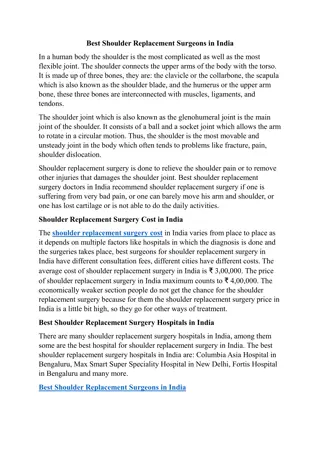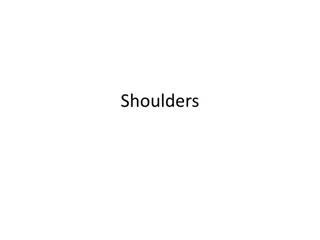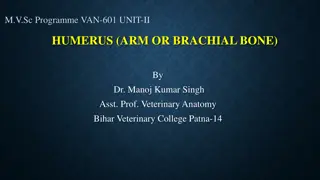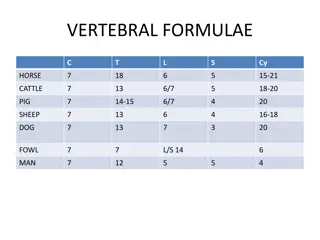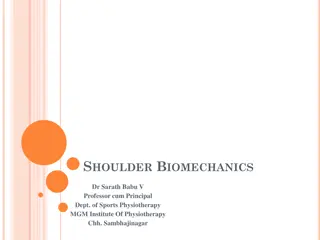Best Shoulder Replacement Surgeons In India
In a human body the shoulder is the most complicated as well as the most flexible joint. The shoulder connects the upper arms of the body with the torso. It is made up of three bones, they are: the clavicle or the collarbone, the scapula which is also known as the shoulder blade, and the humerus or
0 views • 2 slides
Shoulder Anatomy and Rotator Cuff Injuries
Shoulders are complex joints made up of the humerus, clavicle, and scapula, with three key joints - the glenohumeral, acromioclavicular, and sternoclavicular. The rotator cuff, consisting of four muscles, plays a crucial role in shoulder function. Rotator cuff injuries like tears or tendonitis are c
0 views • 30 slides
Anatomy of the Upper Limb: Clavicle, Scapula, Humerus
The upper limb anatomy includes detailed descriptions of the clavicle, scapula, and humerus bones. The clavicle is a long bone that articulates with the sternum and scapula, while the scapula lies on the posterior chest wall and has important bony landmarks like the acromion and glenoid cavity. The
2 views • 15 slides
Anatomy of the Ox Radius: Structure and Function
The radius of an ox is the larger and shorter bone of the forearm, situated between the elbow and carpal joints. It consists of a shaft with distinct surfaces and borders, facilitating muscle attachments and joint movements in the forelimb. The proximal extremity articulates with the humerus, while
0 views • 11 slides
Anatomy of the Humerus Bone in Veterinary Science
The humerus bone, also known as the arm or brachial bone, plays a crucial role in forming the shoulder and elbow joints. It features a shaft with distinct surfaces and nutrient foramen. The proximal extremity includes a head, neck, tuberosities, and a bicipital groove for various muscle attachments.
0 views • 15 slides
Forensic Anthropology and Missing Persons Investigation
The investigation into missing persons using forensic anthropology techniques, focusing on the analysis of bones like the humerus for height approximation and identification. Families await closure as the FBI looks into washed ashore bones, potentially bringing answers and resolving insurance claims
0 views • 13 slides
Sex Determination Through Bone Analysis in Forensic Anthropology
In forensic anthropology, the pelvis and skull are crucial in sex determination, with additional assistance from femur, tibia, and humerus measurements. This data sheet guides on circling male or female based on traits like sub-pubic angle, pelvic cavity shape, eye orbit sharpness, zygomatic process
0 views • 33 slides
Complications of Fractures: Types and Risks
Complications of fractures can be classified as general, local early, and late complications. General complications include shock, embolisms, and fever while local complications involve injuries to nearby tissues and infections. Early local complications can lead to visceral, vascular, nerve injurie
0 views • 29 slides
Comparative Anatomy of Mammals: Vertebral and Skeletal Structures
Explore the variations in vertebral formulae, rib pairs, rib shaft characteristics, scapula morphology, humerus features, ulna differences, and metacarpals/digits among horse, cattle, pig, sheep, dog, and fowl. Detailed images and descriptions offer insights into the distinct skeletal structures of
0 views • 9 slides
The Bones of Upper and Lower Limbs
Explore the classification and main features of bones in the upper and lower limbs, including the arm, forearm, hand, thigh, leg, foot, and pectoral girdle. Learn about the clavicle, scapula, and humerus in detail, identifying key structures and functions to enhance your knowledge of human anatomy.
0 views • 24 slides
The Elbow Joint Complex and Its Functionality
The elbow joint complex is crucial for both mobility and stability of the hand, serving a uniaxial diarthrodial joint of hinge type with one degree of freedom of motion. Composed of the humeroulnar, humeroradial, proximal radioulnar, and distal radioulnar joints, it articulates surfaces such as the
0 views • 47 slides
SHOULDER BIOMECHANICS
The shoulder complex, consisting of the clavicle, scapula, and humerus, comprises three primary joints enabling a wide range of motion. Its articulations facilitate the elevation and positioning of the hand, with the glenohumeral joint providing exceptional mobility. The sternoclavicular joint conne
0 views • 90 slides
